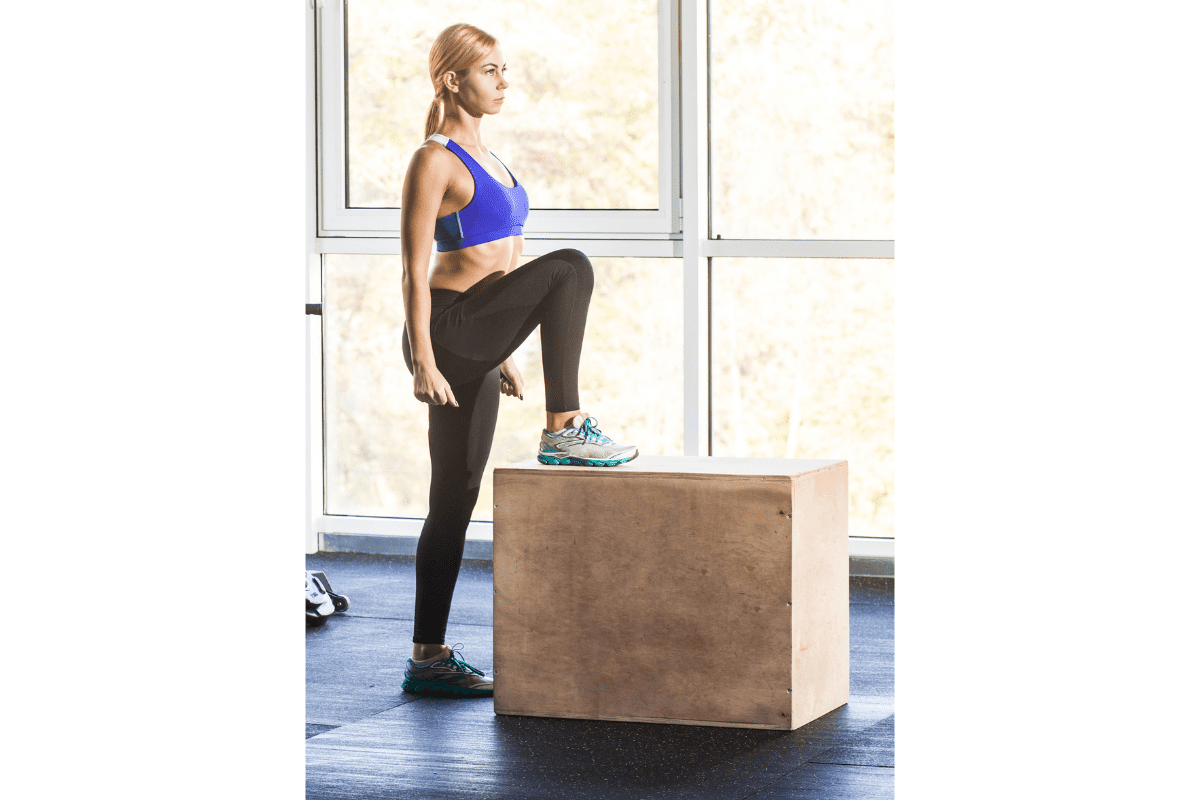Dumbbell Step Ups (How To, Muscles Worked, Benefits)
The dumbbell step-up is a lower-body exercise used by athletes to train single-leg strength and power. This is a great movement for field, court, and track athletes looking to increase force production on a single leg.
In this guide, I’m going to teach you how to properly do Dumbbell Step Ups, what the benefits are along with a few alternatives in case you need them.
How To Do Dumbbell Step Ups
Equipment Needed
- Dumbbells (Kettlebells can also be used if needed)
- A very stable surface to step up to. (Ideally, a box or bench that is stable, heavy, and well balanced)
Muscles Worked
- Quads (Rectus Femoris, Vastus Lateralis, Vastus Medialis, Vastus Intermedius)
- Hamstrings (Biceps Femoris, Semimembranosus, Semitendinosus)
- Glutes (Gluteus Maximus, Gluteus Medius)
- Secondarily: Forearm Flexors
Note: The height of the box will factor into the amount of Quad and/or Hamstring involvement. The higher the box, the more the hamstrings will be emphasized.
Step-by-Step Instruction
- With the dumbbells at your side, hinge at the waist and bend your knees to lift. Keep a neutral spine as you are lifting the dumbbells. NEVER ROUND YOUR BACK WHILE LIFTING.
- Use a box height that is going to allow your hip and knee flexion to be as similar as possible to your stride while sprinting or bounding.
- Place one foot on the box, and drive the other leg’s knee up.
- The leg drive should be fast and explosive. (Quick note: keep the up leg’s foot pulled up toward the shin).
- Engage the glutes and pause for a brief second at the top of the movement.
- Carefully lower the leg back down and prepare for the next repetition.
Coaching Points
A stable box cannot be overstated here. If the box is not stable, do not do step-ups. The risk-to-reward ratio should always be considered with all exercises and implements.
Box height is very important to benefit from this movement. If the box height is too short or high, there will be less sport or movement-specific training.
As with all movements, quality movement is better than the quantity of weight. This movement is typically programmed for specific training of single-leg drive and down-leg stability. Make sure the knee drive is explosive.
If the dumbbells are getting in the way of your knee drive, hold the dumbbells in the front rack or goblet position.
Benefits of Dumbbell Step-Ups
Dumbbell Step-Ups are a great exercise for building single-leg strength.
Step ups require you to balance on one foot while stepping onto a box or platform, which helps to improve balance, stability, and coordination.
Step-ups are an extremely versatile exercise. By adjusting the height of the box being used, you can alter which muscle groups will be targeted. A taller box will emphasize the hamstrings more while a lower box will emphasize the quads.
DB Step-Up Variations
You can make slight tweaks to DB Step Ups to focus on different points of emphasis (balance or power for example).
Dumbbell Dynamic Step Up
Holding a dumbbell (LIGHT) in each hand and standing in front of a box. Hold one foot just over the box (imitating hip flexion) and dynamically drive into the step up. Pause the top of the step up to engage down leg stability.
Single Arm DB Step-Up
If you want to challenge your balance and core, try Single Arm DB Step Ups. Instead of holding a dumbbell in both hands, hold a single dumbbell in one hand. I prefer to hold the dumbbell in the opposite hand of the leg that is working. (although same-side has its own benefits and challenges)
Because you’re weighted on only one side, your core has to work to keep your torso upright and it places an emphasis on your ability to balance as well.
DB Step-Up Alternatives
Limited by equipment, ability or injury? Here are a few alternatives you may be able to use as a substitution. Want even more options? Here are 8 of my favorite alternatives for Dumbbell Step-Ups.
Barbell Step Ups
Don’t have dumbbells? Barbell Step Ups can be an obvious replacement for DB Step Ups.
However, Barbell Step Ups does come with a higher amount of risk. If you lose your balance while doing dumbbell step-ups, it’s relatively easy to drop the dumbbells if needed and catch your balance. Bailing a barbell to catch your balance while doing step-ups can be much more dangerous.
Goblet Reverse Lunge With Knee Drive
Holding a dumbbell or kettlebell in the goblet position, reverse lunge, and drive into a knee drive. Hold this position for 1 second before going into the next repetition.
DB Forward Lunge + Reverse Lunge
Hold a dumbbell or kettlebell in the goblet position, forward lunge, maintain your balance and go right into the reverse lunge.
More Links and Info
Looking for more Lower Body Lifts? Check out the Exercise Library where there is a growing collection of exercises to help you reach your athletic potential. All for free.

